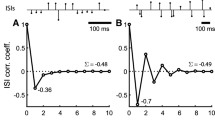Abstract
A method is described to test the predictability of impulse responses from responses to Gaussiandistributed random stimulation by means of the reverse correlation analysis. In addition, this analysis is tested as to whether it can handle responses of nonlinear systems to random inputs of strongly limited frequency content, which is often the case in data from physiological experiments. The basis for all computation is a simple backward averaging (peri-spike averaging, Istorder PSA) of the noise input triggered from the output pulsatile events, which was extended to two-dimensional peri-spike averaging (2nd-order PSA). These functions were shown to represent the 1st- and 2nd-order Wiener kernel and were taken to calculate the 1st-and 2nd-order response predictions to a given short random test sequence. Different models of impulse-initiating mechanisms were tested for their expression of nonlinearities in these PSAs. Output impulse densities of test sequence (the observed response) could be fairly well approximated by the result of the computations (the predicted response). The difference between observation and prediction was evaluated and expressed as the mean-least squares error. In some of the data the 2nd-order kernel seems sufficient to account for the major nonlinear component, in others, kernels of orders higher than two.
Similar content being viewed by others
References
Baker Jr CL (1978) Nonlinear systems analysis of computer models of repetitive firing. Biol Cybern 29:115–123
Boer E de, Kuyper P (1968) Triggered correlation. IEEE Biomed Eng 15:169–179
Bryant HL, Segundo JP (1976) Spike initiation by transmembrane current: a white-noise analysis. J Physiol 260:279–314
Citron MC, Marmarelis VZ (1987) Applications of minimum-order Wiener modeling to retinal ganglion cell spatiotemporal dynamics. Biol Cybern 57:241–247
Eggermont JJ, Johannesma PIM, Aertsen AMH (1983) Reverse-correlation methods in auditory research. Q Rev Biophys 16:341–414
Eysel UTh (1971) Computer simulation of the impulse pattern of muscle spindle afferents. Kybernetik 8:171–179
French AS (1976) Practical nonlinear system analysis by Wiener kernel estimation in the frequency domain. Biol Cybern 24:111–119
French AS, Stein RB (1970) A flexible neural analog using integrated circuits. IEEE Biomed Eng 17:248–253
French AS, Wong RKS (1977) Non-linear analysis of sensory transduction in an inset mechano-receptor. Biol Cybern 26:231–240
Holden AV (1976) Models of the stochastic activity of neurons. In: Levin L (ed) Lecture Notes in Biomathematics. Springer, Berlin Heidelberg New York, p 368
Ito M, Oshima T (1962) Temporal summation of after hyperpolarization following a motor neuron spike. Nature 195:910–911
Korenberg MJ, French AS, Voo SKL (1988) White-noise analysis of nonlinear behaviour in an insect sensory neuron: kernel and cascade approaches. Biol Cybern 58:313–320
Kröller J, Grüsser O-J (1982) Responses of cat dorsal spino-cerebellar tract neurons to sinusoidal stretching of gastrocnemius muscle. Pflügers Arch 395:99–107
Kröller J, Weiss L (1983) The silent period in the stretch response of Ia-activated dorsal spino-cerebellar tract neurons to sinusoidal muscle stretch in cats. Biol Cybern 48:195–199
Kröller J, Grüsser O-J, Weiss L (1985) The response of primary muscle spindle endings to random muscle stretch: a quantitative analysis. Exp Brain Res 61:1–10
Kröller J, Grüsser O-J, Weiss L-R (1988) Superimposing noise linearizes the responses of primary muscle spindle afferents to sinusoidal muscle stretch. Biol Cybern 60:131–137
Lee YW, Schetzen M (1965) Measurement of the Wiener kernels of a nonlinear system by cross-correlation. Int J Control 2:237–254
Marmarelis PZ, Marmarelis VZ (1978) Analysis of physiological systems. Plenum Press, New York and London, pp 487
Marmarelis VZ, Citron MC, Vivo CP (1986) Minimum-order Wiener modelling of spike-output systems. Biol Cybern 54:115–123
Moore GP, Stuart DG, Stauffer GK, Reinking R (1975) White noise analysis of mammalian muscle repectors. In: McCann GD, Marmarelis PZ (eds) Proc. of the 1st symposium on testing and identification on nonlinear systems. California Institute of Technology, Pasadena, California, pp 316–324
Pöpel B, Querfurth H (1984) The transducer and encoder of frog muscle spindles are essentially nonlinear. Physiological conclusions from white-noise analysis. Biol Cybern 51:21–32
Spekreijse H, Oosting H (1970) Linearizing: a method for analysing and synthesizing nonlinear systems. Kybernetik 7:22–31
Stark L (1969) The pupillary control system: its nonlinear adaptive and stochastic engineering design characteristics. Automatica 5:655–676
Swerup C (1978) On the choice of noise for the analysis of the peripheral auditory system. Biol Cybern 29:97–104
Wickesberg RE, Geisler CD (1984) Artifacts in Wiener kernels estimated using Gaussian white noise. IEEE Biomed Eng 31:454–461
Wiener N (1958) Nonlinear problems in random theory. Wiley, New York
Author information
Authors and Affiliations
Rights and permissions
About this article
Cite this article
Kröller, J. Band-limited white noise stimulation and reverse correlation analysis in the prediction of impulse responses of encoder models. Biol. Cybern. 67, 207–215 (1992). https://doi.org/10.1007/BF00204393
Received:
Accepted:
Issue Date:
DOI: https://doi.org/10.1007/BF00204393




